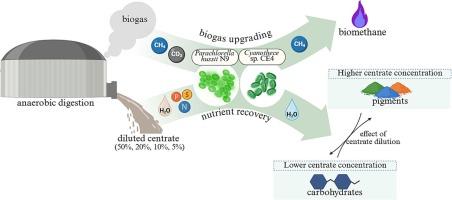Digestate dilution shapes carbohydrate and pigment production during microalgal and cyanobacterial-based biogas upgrading
IF 4.5
2区 生物学
Q1 BIOTECHNOLOGY & APPLIED MICROBIOLOGY
Algal Research-Biomass Biofuels and Bioproducts
Pub Date : 2025-09-01
DOI:10.1016/j.algal.2025.104290
引用次数: 0
Abstract
Microalgae and cyanobacteria offer a promising platform for integrating sustainable technologies aligned with circular and green economy goals. However, current studies often focus on a limited number of genera and overlook how centrate dilution influences metabolite production. This study investigates the potential of the freshwater microalga Parachlorella hussii N9 and the marine cyanobacterium Cyanothece sp. CE4 for photobiological biogas upgrading coupled with nutrient recovery from centrate, assessing the impact of centrate dilution on carbohydrate and pigment content. By varying centrate concentration (5–50 %) in tap or seawater, this research explores how the biogas-to-centrate ratio can be adjusted for biomass production, TN and CO2 abatement, and to target specific metabolites, advancing circular bioeconomy strategies. The microalga exhibited faster growth than the cyanobacterium, achieving the stationary phase in three days, and higher cellular and soluble carbohydrate productivity (up to 237 and 75 mg L−1d−1, respectively). CO₂ abatement (almost complete in all treatments) reached ∼513 ± 28 mg L−1 of culture, while nitrogen removal considering initial centrate concentration ranged between 32 and 250 mg N L−1, but 100 % TN removal was exhibited only with the lower centrate concentrations (5–10 %). These lower concentrations also induced the highest carbohydrate content in biomass (41–44 % dw). In contrast, pigment content increased with higher centrate concentrations: the microalga reached 3.6 % dw of chlorophyll at 50 % centrate, while the cyanobacterium produced up to 0.6 % dw of C-phycocyanin; both strains showed similar carotenoid content (0.4–0.5 % dw). This study highlights the potential of adjusting centrate dilution to target microalgal metabolism for integrated CO₂ capture, nutrient recovery, and bioproduct generation.

消化稀释形状碳水化合物和色素生产过程中的微藻和蓝藻为基础的沼气升级
微藻和蓝藻为整合符合循环和绿色经济目标的可持续技术提供了一个有前途的平台。然而,目前的研究往往集中在有限的属,忽视了浓缩稀释如何影响代谢物的产生。本研究探讨了淡水微藻胡氏伞藻N9和海洋蓝藻Cyanothece sp. CE4在光生物沼气升级和浓缩液中营养物质回收中的潜力,评估了浓缩液稀释对碳水化合物和色素含量的影响。通过改变自来水或海水中的浓缩浓度(5 - 50%),本研究探讨了如何调整沼气-浓缩比,以实现生物质生产、TN和CO2减排,并针对特定代谢物,推进循环生物经济战略。微藻表现出比蓝藻更快的生长,在3天内达到固定阶段,并且具有更高的细胞和可溶性碳水化合物产量(分别高达237和75 mg L−1d−1)。CO₂的减除(在所有处理中几乎完全)达到了培养物的~ 513±28 mg L−1,而氮的去除率考虑到初始浓度在32和250 mg N L−1之间,但只有在较低的浓度(5 - 10%)下才表现出100%的TN去除率。这些较低的浓度也诱导了最高的生物量碳水化合物含量(41 - 44% dw)。相比之下,色素含量随着浓度的增加而增加:在浓度为50%时,微藻的叶绿素含量达到3.6% dw,而蓝藻的c -藻蓝蛋白含量高达0.6% dw;两菌株类胡萝卜素含量相近(0.4 ~ 0.5% dw)。这项研究强调了调整浓度稀释以瞄准微藻代谢的潜力,以实现二氧化碳捕获、营养恢复和生物产物生成。
本文章由计算机程序翻译,如有差异,请以英文原文为准。
求助全文
约1分钟内获得全文
求助全文
来源期刊

Algal Research-Biomass Biofuels and Bioproducts
BIOTECHNOLOGY & APPLIED MICROBIOLOGY-
CiteScore
9.40
自引率
7.80%
发文量
332
期刊介绍:
Algal Research is an international phycology journal covering all areas of emerging technologies in algae biology, biomass production, cultivation, harvesting, extraction, bioproducts, biorefinery, engineering, and econometrics. Algae is defined to include cyanobacteria, microalgae, and protists and symbionts of interest in biotechnology. The journal publishes original research and reviews for the following scope: algal biology, including but not exclusive to: phylogeny, biodiversity, molecular traits, metabolic regulation, and genetic engineering, algal cultivation, e.g. phototrophic systems, heterotrophic systems, and mixotrophic systems, algal harvesting and extraction systems, biotechnology to convert algal biomass and components into biofuels and bioproducts, e.g., nutraceuticals, pharmaceuticals, animal feed, plastics, etc. algal products and their economic assessment
 求助内容:
求助内容: 应助结果提醒方式:
应助结果提醒方式:


